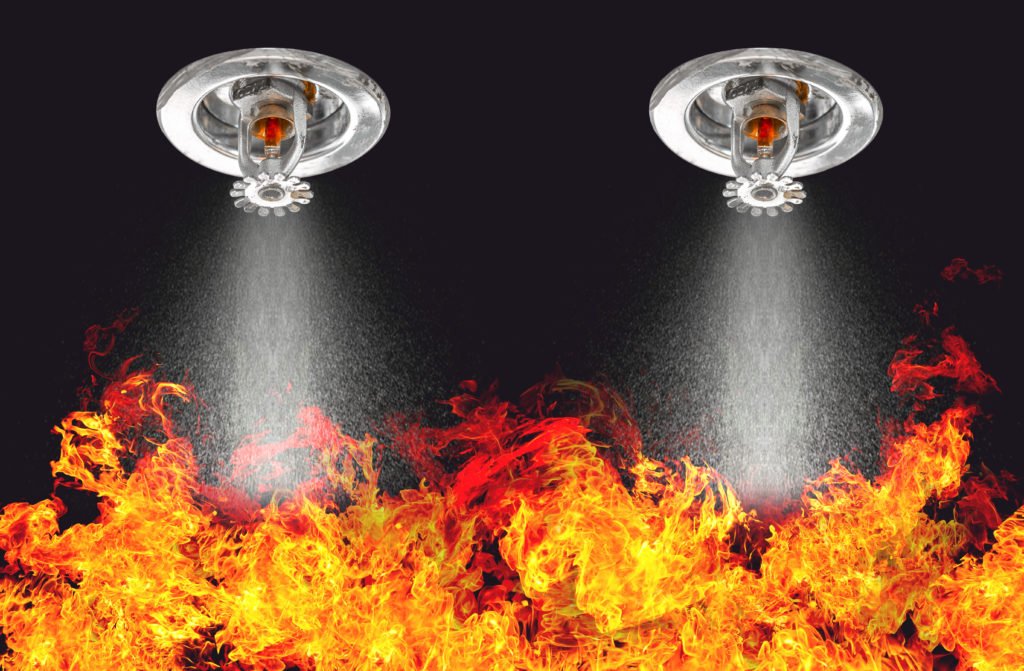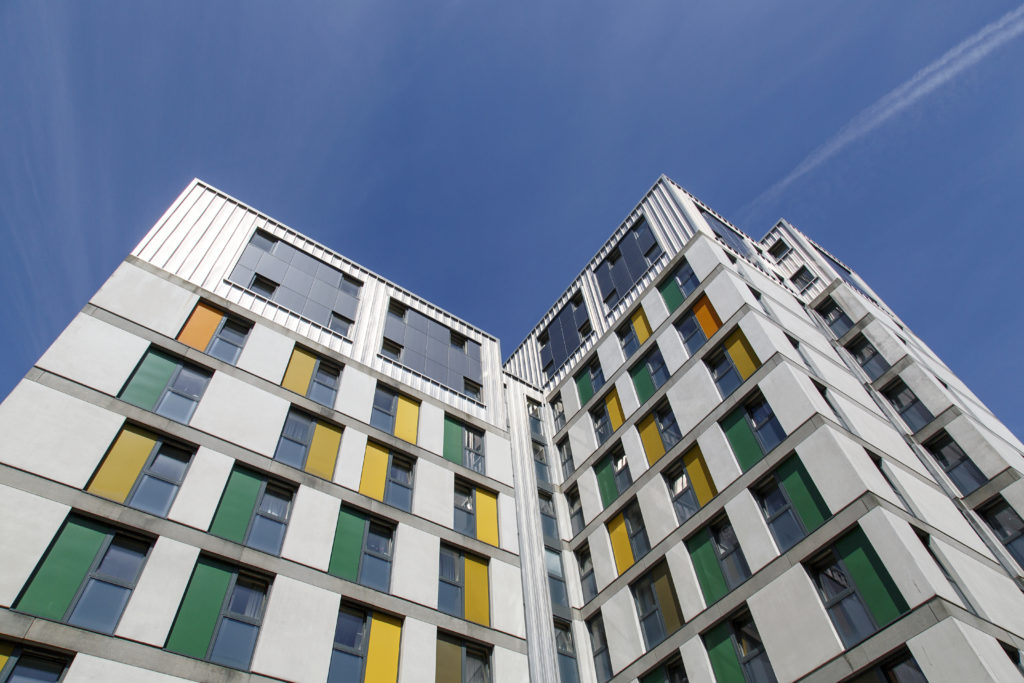A fire sprinkler system is a simple, but key, active component of a domestic or commercial building’s fire protection system.
Installed in ceilings or side walls, the system consists of a water supply, a water distribution piping system and sprinkler heads. The sprinkler discharges water automatically when a fire is detected, though it is not triggered by smoke. It controls or extinguishes the fire, so is both a fire detection and suppression system.
Sprinkler systems have been around since the late 19th century, when they were pioneered by Hiram Stevens Maxim. They are now extensively used worldwide, with over 40 million sprinkler heads fitted each year. A system will generally involve water being held under pressure in a network of pipes running through a building.
Fire sprinkler types
There are four main types of fire sprinkler system:
- Wet pipe
- Dry pipe
- Deluge
- Pre-action
In a wet pipe fire sprinkler system, the most common type in residential buildings, cold water is stored under pressure in the pipes and is released immediately by sprinkler heads when the predetermined heat level is reached.
Dry pipe sprinkler systems take slightly longer to activate and are used in unheated/unoccupied buildings where pipes may freeze and burst. Nitrogen gas or pressurised air is stored in the pipes, connected to a water storage tank or main. On activation by a fire, the air leaks out of the pipes, causing the water to flow through the pipes to the sprinkler heads.
Deluge sprinkler systems are typically used in areas where rapid fire damage is a major concern, such as warehouse loading bays and high-rise buildings. In these systems, the nozzle is always open. They are triggered by an alarm that opens a water release valve.
Pre-action sprinkler systems are a combination of wet and dry pipe systems, typically used in areas at high-risk of water damage. Water is not stored in the pipes until a fire is detected, when the water is released to the sprinkler heads. The response time is as fast as a standard wet pipe sprinkler system. Automatic fire sprinkler systems are also available and are effective in large areas such as offices and shopping centres.
SMART (Simultaneous Monitoring, Assessment and Response Technology) sprinklers, which use more than one detection technology, and should react more quickly, are currently being developed.
Sprinklers that eject water mist instead of water, are another alternative.
Fire sprinkler heads
A fire sprinkler head is the component of a sprinkler system that discharges water when the fire has been detected. It comes in assorted designs.

With conventional heads, suitable for most residential fire sprinkler systems, some water is discharged onto the ceiling.
Upright or pendant spray sprinklers aim all the water straight down and are suited to rooms with high ceilings.
Heads need not be obtrusive and may be recessed in the ceiling or covered with resin caps to make them more aesthetically pleasing.
Side wall sprinklers attach to a high point on the wall. They usually give wider water coverage than conventional sprinkler heads.
The plug inside the head that holds back the water may be made of Wood’s metal, a mixture of bismuth, lead, tin, and cadmium that melts at a relatively low temperature, or a small glass bulb containing a glycerin-based liquid that expands and shatters when it gets hot, releasing the water.
Each sprinkler head activates independently. Only sprinklers above the fire will operate, maximising water pressure over the fire and reducing fire and water damage to the building. Sprinklers use far less water than fire hoses.
Read more: Fire sprinkler systems: a guide to designs, colour codes and suppliers
Fire sprinkler installation
Whether residential or commercial, a fire sprinkler system should only be installed by a company certified by a reputable body, such as BRE Global Loss Prevention Certification Board (LPCB) or Exova Warringtonfire. See also the UK Accreditation Service.
Only hardware and components that have been third-party tested and approved should be used.
If retro-fitted, the position of existing pipe work, electrical fittings and water pressure from the mains need to be considered. A water storage system may be needed.
BAFSA outlines the standards to which sprinklers should be installed.
Fire sprinkler system costs
Ideally sprinkler systems should be incorporated into building plans, although retro-fitting need not be prohibitively disruptive or expensive.
Residential fire sprinklers are not expensive, costing around £1 per sq ft or about £1500 – £2000 for a three-bedroom house, much the same as a carpet. It is estimated that their cost can be recovered in around 10 years through reduced insurance premiums and reduced disruption to business continuity.
Installed in a new building a sprinkler system costs around 1-2% of the total build cost. For an industrial building, they cost between £33 and £35 per square metre.
Sprinkler systems do not require a great deal of maintenance, perhaps two visits a year by the installer plus regular visual checks.
There is no doubt that sprinklers save lives, but they also save money in the long run. Fire sprinkler systems control, or put out, 99% of fires in buildings where they are installed. Losses from fires in buildings with sprinklers are estimated to be only one tenth of those in unprotected buildings.
A sprinkler system is a good investment that will last for many years, bringing both safety and peace of mind. It can be a life-saver. Read more analysis of the effectiveness of sprinkler systems here.
Why are fire sprinklers so underrated?
Sprinklers have long been an underrated tool in the active fire suppression armoury, Iain Cox, Chair of the Business Sprinkler Alliance (BSA), tells FIREX TV in the video below.
Cox, who is also vice chair of the National Fire Sprinkler Network (NFSN), believes this is partly because they’ve been around so long they’re almost taken for granted. Yet the design of sprinkler protection systems and design have changed relatively little over time, surely this would emphasise their effectiveness? Speaking outside the Sprinkler and Suppression Zone at FIREX 2019, Cox also challenges some of the myths that persist around sprinklers.
Cox was recently given FM Global’s second annual International Codes and Standards Advocacy Award for his efforts in championing the value of sprinklers.
There also continues to be much noise from the fire safety industry around the effectiveness of sprinklers, and why building managers or owners should look to invest in them – whether this is in office buildings, or high rise apartment blocks. The South Yorkshire Fire & Rescue department have recently invested in fitting sprinklers in around 650 flats across the county in a bid to prompt owners or accommodation to consider sprinklers as a long-term measure to keep their tenants safe. Meanwhile, when a fire broke out at a business in Hastings in October 2020, the building’s sprinkler system helped “prevent serious damage”, which could have been catastrophic to the company in question.
In addition, Housing Secretary, Robert Jenrick, has included measures that make sprinkler system installation mandatory in high rise blocks of flats that stand over 11m tall in an update to Approved Document B, as part of the Building Safety Bill. This follows measures set out by Dame Judith Hackitt in her Independent Review of Building Regulations and Fire Safety following the Grenfell Tower tragedy. This development means that any new flat developments with a floor at the 11m threshold (typically around four floors), will be required to be fitted with a sprinkler or alternative fire suppression system.









